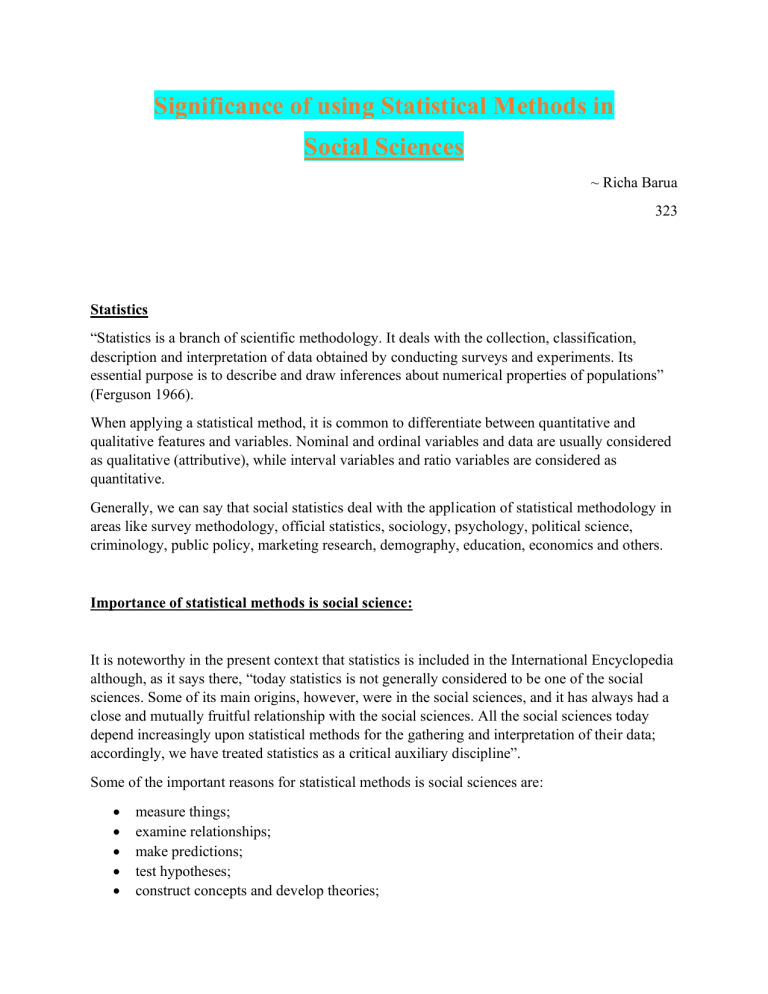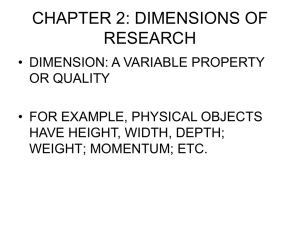
Significance of using Statistical Methods in Social Sciences ~ Richa Barua 323 Statistics “Statistics is a branch of scientific methodology. It deals with the collection, classification, description and interpretation of data obtained by conducting surveys and experiments. Its essential purpose is to describe and draw inferences about numerical properties of populations” (Ferguson 1966). When applying a statistical method, it is common to differentiate between quantitative and qualitative features and variables. Nominal and ordinal variables and data are usually considered as qualitative (attributive), while interval variables and ratio variables are considered as quantitative. Generally, we can say that social statistics deal with the application of statistical methodology in areas like survey methodology, official statistics, sociology, psychology, political science, criminology, public policy, marketing research, demography, education, economics and others. Importance of statistical methods is social science: It is noteworthy in the present context that statistics is included in the International Encyclopedia although, as it says there, “today statistics is not generally considered to be one of the social sciences. Some of its main origins, however, were in the social sciences, and it has always had a close and mutually fruitful relationship with the social sciences. All the social sciences today depend increasingly upon statistical methods for the gathering and interpretation of their data; accordingly, we have treated statistics as a critical auxiliary discipline”. Some of the important reasons for statistical methods is social sciences are: • • • • • measure things; examine relationships; make predictions; test hypotheses; construct concepts and develop theories; • • • • • • • explore issues; explain activities or attitudes; describe what is happening; present information; make comparisons to find similarities and differences; summarize results in a meaningful and convenient form; draw conclusions about populations based only on sample results. Statistics and statistical analyses have become a key feature of social science: statistics is employed in economics, psychology, political science, sociology and anthropology. The use of statistics has become so widespread in the social sciences that many universities such as Harvard, have developed institutes focusing on “quantitative social science.” Functions of statistical methods are numerous: • • • • the methods of descriptive statistics have an important application for describing natural phenomena inferential statistics is used for inductive reasoning about unknown properties of a larger group using the known indicators of the causes hypothesis testing most frequently refers to the results of one, two or more causes, on the basis of which it is possible to draw conclusions on the problem of the research, by accepting or refuting an initial hypothesis analyze some of the causal factors underlying complex and otherwise bewildering events. Statistical methods can be applied to a variety of social situations. In today’s data-driven world, statistics is used to make policy decisions, study social and behavioral changes, and answer important cultural questions. Conclusion Statistical methods have played a very important role in social sciences. In every applied research effort statistical techniques are compulsory to reach a non-questionable conclusion. It is strongly believed that advanced statistical methods can be employed heavily in this area. It seems that researchers rely more on classical statistical methods although they could benefit from the use of newer and advanced techniques.



